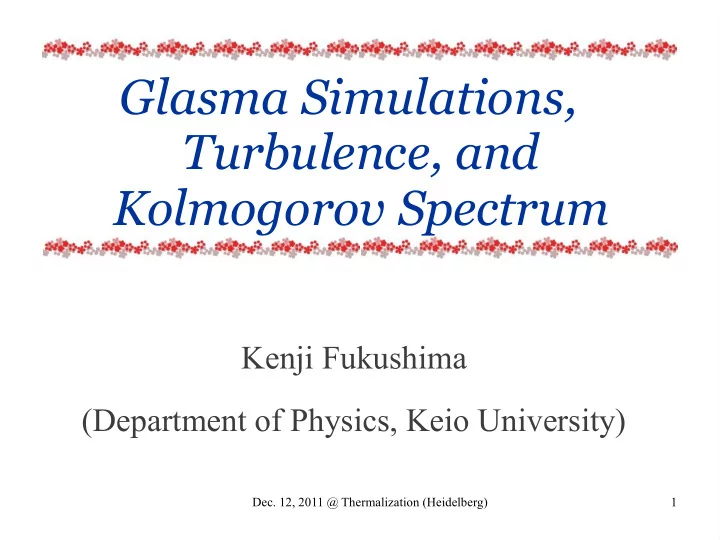

Glasma Simulations, Turbulence, and Kolmogorov Spectrum Kenji Fukushima (Department of Physics, Keio University) Dec. 12, 2011 @ Thermalization (Heidelberg) 1
Glasma = (Color) Glass + Plasma Intuitive Picture of Glasma * Boost Invariance * Coherent Fields (amp. ~ 1/ g ) * Flux Tube (size ~ 1/ Q s ) * Expanding * Unstable in h (cascade to UV) * Hydro Input? Dec. 12, 2011 @ Thermalization (Heidelberg) 2
Formulations Initial Condition MV Model Color source distribution is Gaussian (No spatial correlation in transverse direction) Solve the Poisson Eq Gauge Configuration Dec. 12, 2011 @ Thermalization (Heidelberg) 3
Formulations Time Evolution η =τ − 1 ∂ τ A η i =τ∂ τ A i , E E − 1 D η F η i +τ D j F ji i =τ ∂ τ E − 1 D j F j η η =τ ∂ τ E Classical Equations of Motion in the Bjorken Coordinates (in the “temporal” gauge A t = 0) Ensemble Average 〈〈 O [ A ]〉〉 ρ t , ρ p ∼ ∫ D ρ t D ρ p W x [ρ t ] W x ' [ρ p ] O [ A [ρ t , ρ p ]] Stress Tensor (Energy, Pressures) Quantum fluctuations partially included in the initial state Dec. 12, 2011 @ Thermalization (Heidelberg) 4
Example of Simulations Demonstration with smooth source (one flux-tube) 1 U 1 ( 1 ) ( x , y )] tr [τ Dec. 12, 2011 @ Thermalization (Heidelberg) 5
Example of Simulations E 1 True electric field ∼ E i / τ Dec. 12, 2011 @ Thermalization (Heidelberg) 6
Example of Simulations E h Dec. 12, 2011 @ Thermalization (Heidelberg) 7
Example of Simulations U 1 Dec. 12, 2011 @ Thermalization (Heidelberg) 8
Example of Simulations U h A η , E i fast modes (multiple time scales) Dec. 12, 2011 @ Thermalization (Heidelberg) 9
Real Simulations Initial Transverse Spectrum Evolution of Longitudinal Spectrum Fukushima-Gelis Dec. 12, 2011 @ Thermalization (Heidelberg) 10
Some Known Facts about Glasma Simulation Free streaming after 1/ Q s P L ≃ 0 Glasma instability at 100~1000/ Q s Instability ends when non-Abelianized Then spectrum shows asymptotic scaling (Tomorrow...) Fukushima-Gelis Romatschke-Venugopalan Dec. 12, 2011 @ Thermalization (Heidelberg) 11
Questions Physics Problems 1. What would be the role of the color flux-tube structure in the thermalization? 2. Why is the time scale of the Glasma instability such long; relevant time scale? 3. What is the very initial rise? Sensitive to the initial condition; deterministic? Technical Problems 1. Why not continuum but lattice? 2. Implementation of the JIMWLK improvement Dec. 12, 2011 @ Thermalization (Heidelberg) 12
Color Flux-Tube Structure In the MV model no color flux-tube is included. (No “serious” simulation with color flux-tube structure exists so far to the best of my knowledge.) If the flux-tube is implemented, the Nielsen-Olesen instability should be seen. (Fujii, Itakura, Iwazaki) (Impact on CME) ω 2 = p z 2 + 2 ∣ g B ∣( n + 1 / 2 )+ m 2 − 2 s g B Transverse correlation from the JIMWLK evolution. Solving the Langevin equation... (Weigert) Dec. 12, 2011 @ Thermalization (Heidelberg) 13
Large Amplitude in SU(2) Gauge fields as angle variables No problem if we use the continuum variables... Why we stick to the link variables...? Dec. 12, 2011 @ Thermalization (Heidelberg) 14
Initial Rise Still weak but seen till ~1/ Qs Implication? Wrong choice of initial configuration? What is the initial spectrum? Only quantum? Dec. 12, 2011 @ Thermalization (Heidelberg) 15
When Turbulent? Reynolds number R = U 0 L ν L – typical size of the system U – typical velocity of the system n – viscosity From Wikipedia Dec. 13, 2011 @ Thermalization (Heidelberg) 16
When Turbulent? Typically a flow becomes turbulent for R ~ 10 3 Reynolds number in a turbulent flow R = u ( l ) l ν l – typical scale of eddy size u – typical size of eddy velocity n – viscosity Larger Eddies → Smaller Eddies → Kolmogrov (Smallest) Scale (stabilized by viscosity) Dec. 13, 2011 @ Thermalization (Heidelberg) 17
Reynolds Number In many cases people would think as follows: R ∼ (Inertial Term) (Viscous Term) 4 ex) 3 η+ζ s ∂ s ∂ τ = s τ + 1 R (τ)= T τ 4 2 T τ 3 η+ζ =− s τ ( 1 − R − 1 ) More useful to think R in turbulence as: R ∼ (Time Scale of Molecular Motions) (Time Scale of Turbulent Spreading) for fixed box size Turbulence is much for efficient for (heat) transport Dec. 13, 2011 @ Thermalization (Heidelberg) 18
Question What is the effective theory of QCD in the limit of ? R →∞ Hint: Scaling Analysis Dec. 13, 2011 @ Thermalization (Heidelberg) 19
Kolmogorov Scalings Energy spectrum l d : Kolmogorov Smallest Scale This is only one typical output from scaling. Dec. 13, 2011 @ Thermalization (Heidelberg) 20
Kolmogorov Hypothesis Scaling functions of n and e (in a homogeneous isotropic turbulence) Kolmogorov Length Scale ∼ η=ν 3 / 4 ε − 1 / 4 1 / 2 ε − 1 / 2 Kolmogorov Time Scale ∼ σ=ν Only dependence on e (in an inertial region up to the Kolmogorov length scale) Velocity p -point Function 2 / 3 r 2 / 3 S 2 ( r )= C ε p / 3 r p / 3 S p ( r )= C p ε Dec. 13, 2011 @ Thermalization (Heidelberg) 21
Dimensional Analysis Safe from gauge ambiguity A τ = 0(gauge) A η ∝ τ 2 = 0 at τ= 0 Dec. 13, 2011 @ Thermalization (Heidelberg) 22
Questions The true question is not whether it is Kolmogorov or not, but the true question is whether the Kolmogorov hypothesis holds or not... Diagrammatic derivations (Wyld-Shut'ko theory, Hopf theory, etc...) Dec. 13, 2011 @ Thermalization (Heidelberg) 23
Recommend
More recommend